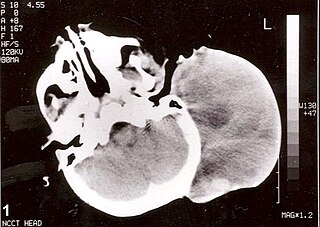
Wilms' tumor or Wilms tumor, also known as nephroblastoma, is a cancer of the kidneys that typically occurs in children, rarely in adults.; and occurs most commonly as a renal tumor in child patients. It is named after Max Wilms, the German surgeon (1867–1918) who first described it.

Rhabdomyosarcoma (RMS) is a highly aggressive form of cancer that develops from mesenchymal cells that have failed to fully differentiate into myocytes of skeletal muscle. Cells of the tumor are identified as rhabdomyoblasts.

Sidney Farber was an American pediatric pathologist. He is regarded as the father of modern chemotherapy for his work using folic acid antagonists to combat leukemia, which led to the development of other chemotherapeutic agents against other malignancies. Farber was also active in cancer research advocacy and fundraising, most notably through his establishment of the Jimmy Fund, a foundation dedicated to pediatric research in childhood cancers. The Dana–Farber Cancer Institute is named after him.

Desmoplastic small-round-cell tumor (DSRCT) is an aggressive and rare cancer that primarily occurs as masses in the abdomen. Other areas affected may include the lymph nodes, the lining of the abdomen, diaphragm, spleen, liver, chest wall, skull, spinal cord, large intestine, small intestine, bladder, brain, lungs, testicles, ovaries, and the pelvis. Reported sites of metastatic spread include the liver, lungs, lymph nodes, brain, skull, and bones. It is characterized by the EWS-WT1 fusion protein.

Dactinomycin, also known as actinomycin D, is a chemotherapy medication used to treat a number of types of cancer. This includes Wilms tumor, rhabdomyosarcoma, Ewing's sarcoma, trophoblastic neoplasm, testicular cancer, and certain types of ovarian cancer. It is given by injection into a vein.
The National Wilms Tumor Study Group (NWTS) is a cancer research cooperative group in the United States formed to study a type of kidney tumor that affects children called Wilms' tumor. In 2001, NWTS merged with several other pediatric oncology cooperative groups to create the Children's Oncology Group (COG). However, the NWTS is still active in name today completing follow-up of the late effects of treatment for patients previously enrolled in its trials. The acronym NWTS is pronounced like the word "nitwits".
The Intergroup Rhabdomyosarcoma Study Group (IRS) was a U.S. and Canadian clinical trial cooperative group created with the mission of studying childhood cancers. In 2000, IRS merged with several other pediatric cooperative groups to form the Children's Oncology Group (COG). This merger has seen its fair share of problems, especially with regard to integrating the various databases associated with each individual cooperative group. One such initiative to consolidate these databases involves caBIG, or cancer BIG, which is guided and supported by the National Cancer Institute (NCI) in Bethesda, Maryland. They published a report on cancer treatment protocols published by the National Institute of Health in 2001, and a separate report in 2011 on improving outcomes for patients with low-risk embryonal rhabdomyosarcoma.

Cancer and Leukemia Group B is a cancer research cooperative group in the United States.

An atypical teratoid rhabdoid tumor (AT/RT) is a rare tumor usually diagnosed in childhood. Although usually a brain tumor, AT/RT can occur anywhere in the central nervous system (CNS), including the spinal cord. About 60% will be in the posterior cranial fossa. One review estimated 52% in the posterior fossa, 39% are supratentorial primitive neuroectodermal tumors (sPNET), 5% are in the pineal, 2% are spinal, and 2% are multifocal.
Clear cell sarcoma of the kidney (CCSK) is an extremely rare type of kidney cancer comprising 3% of all pediatric renal tumours. Clear cell sarcoma of the kidney can spread from the kidney to other organs, most commonly the bone, but also including the lungs, brain, and soft tissues of the body.
Embryonal rhabdomyosarcoma (EMRS) is a rare histological form of cancer in the connective tissue wherein the mesenchymally-derived malignant cells resemble the primitive developing skeletal muscle of the embryo. It is the most common soft tissue sarcoma occurring in children. Embryonal rhabdomyosarcoma is also known as PAX-fusion negative or Fusion-Negative rhabdomyosarcoma, as tumors of this subtype are unified by their lack of a PAX3-FOXO1 fusion oncogene. Fusion status refers to the presence or absence of a fusion gene, which is a gene formed from joining two different genes together through DNA rearrangements. These types of tumors are classified as embryonal rhabdomyosarcoma "because of their remarkable resemblance to developing embryonic and fetal skeletal muscle."

Crenolanib besylate is an investigational inhibitor being developed by AROG Pharmaceuticals, LLC. The compound is currently being evaluated for safety and efficacy in clinical trials for various types of cancer, including acute myeloid leukemia (AML), gastrointestinal stromal tumor (GIST), and glioma. Crenolanib is an orally bioavailable benzamidazole that selectively and potently inhibits signaling of wild-type and mutant isoforms of class III receptor tyrosine kinases (RTK) FLT3, PDGFR α, and PDGFR β. Unlike most RTK inhibitors, crenolanib is a type I mutant-specific inhibitor that preferentially binds to phosphorylated active kinases with the ‘DFG in’ conformation motif.

Diffuse midline glioma (DMG), previously called Diffuse Intrinsic Pontine Glioma (DIPG) is a fatal tumour that arises in the brainstem; most commonly in the pons or thalamus. DMG is believed to be caused by genetic mutations that cause epigenetic changes in cells of the developing nervous system, resulting in a failure of the cells to properly differentiate. Currently, the standard of care is fractionated external beam radiotherapy, as the tumour location precludes surgery, and chemotherapy has shown to be ineffective, however the estimated survival post-diagnosis remains only 9-15 months.
Cancer in adolescents and young adults is cancer which occurs in those between the ages of 15 and 39. This occurs in about 70,000 people a year in the United States—accounting for about 5 percent of cancers. This is about six times the number of cancers diagnosed in children ages 0–14. Globally, nearly 1 million young adults between the ages of 20 and 39 were diagnosed with cancer in 2012, and more than 350,000 people in this age range died from cancer.

Crystal L. Mackall is an American physician and immunologist. She is currently the Ernest and Amelia Gallo Family Professor of Pediatrics and Medicine at Stanford University. She is the founding director of the Stanford Center for Cancer Cell Therapy.

Nirali N. Shah is an American physician-scientist and pediatric hematologist-oncologist, serving as head of the hematologic malignancies section of the pediatric oncology branch at the National Cancer Institute. She researches the translation of immunotherapeutic approaches to treat high-risk hematologic malignancies in children, adolescents and young adults.
Andrea A. Hayes Dixon is an American surgeon. She was the first pediatric surgeon to perform a high-risk, life-saving procedure in children with a rare form of cancer and developed the first orthotropic xenograft model of metastatic Ewing's sarcoma. In 2002, she became the first African American female pediatric surgeon board-certified in the United States.

Brigitte C. Widemann is German-American pediatric oncologist. She is chief of the pediatric oncology branch and clinical deputy director of the center for cancer research at the National Cancer Institute. She is also the special advisor to the NCI director for childhood cancer.












